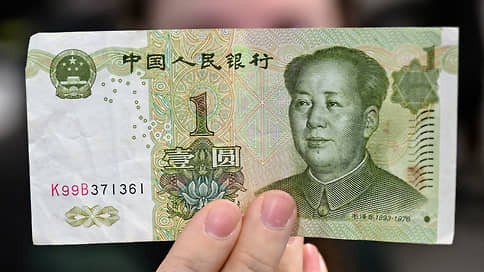At the end of 2023, the yuan became the most traded currency on the Moscow Exchange
[ad_1]

At the end of 2023, the share of Chinese currency trading on the Moscow Exchange reached almost 42%, displacing the US dollar from first place. Yuan trading volume tripled to RUB 34.2 trillion. Demand for other currencies of “friendly” countries is also increasing, but they still occupy a small share in the total trading volume. Over-the-counter trading volumes in the UAE dirham and Indian rupee increased significantly. But exchange trading in these currencies has not yet been launched due to the risk of secondary sanctions.
According to Kommersant’s estimates, based on data from the Moscow Exchange, at the end of 2023, the total volume of trading in major currencies against the ruble in the “today” and “tomorrow” trading modes exceeded 82 trillion rubles. This result is only 4% higher than the previous year. However, the trading structure has changed significantly.
If in 2022 about 87% of the market accounted for trading in the US dollar and euro, then at the end of 2023 these currencies accounted for slightly more than half of the market. At the same time, the dollar occupied less than 40% (RUB 32.5 trillion) of the market, falling to second place. The share of euro trading was less than 18% (14.6 trillion rubles), it took third place. Yuan trading volumes almost tripled over the year, to 34.2 trillion rubles, and with a share of 41.6% it came out on top.
Trading volumes in the currencies of other friendly countries are growing, but so far their shares are insignificant.
Thus, the volume of trading in the Turkish lira increased over the year by more than 17 times, to 465 billion rubles. (share 0.6%). The volume of trading in Kazakh tenge increased almost sixfold – to 388 billion rubles. (0.47%). Trading volumes in the Hong Kong dollar and Belarusian ruble almost doubled – to 73.8 billion rubles. (0.09%) and 50 billion rubles. (0.06%) respectively.
The strong growth in lira and tenge trading is partly due to the low base of 2022 and increased interest in them in the first half of 2023. According to Kommersant’s estimates, by the fall of last year, trading volumes in these currencies had grown to 50 billion rubles. and 40 billion rubles. per month, respectively, but then remained close to the achieved values. The head of the analytical department of Zenit Bank, Vladimir Evstifeev, notes that these currencies are considered as settlement, not investment, and therefore trading volumes correlated with imports, which were actively recovering in the first half of the year and began to slow down in the second half of the year.
Another result of 2023 was a sharp increase in the volume of over-the-counter trading in the UAE dirham.
According to Kommersant’s estimates, based on data from the Central Bank, for 11 months of 2023, the volume of dirham trading exceeded 3 trillion rubles, which is almost ten times more than the figure for the entire 2022.
Operations with the Indian rupee have also intensified. If in January 2023 the volume of such transactions did not even reach 0.5 billion rubles, then in November the figure already reached 37 billion rubles. The Moscow Exchange launched trading in futures for the UAE dirham and the Indian rupee, and also began trading in the UAE dirham-Russian ruble pair, but in a special mode. The bottom line is that from 10:00 to 19:00 standard spot and swap transactions are concluded, and after 19:00 open positions in dirhams are converted into rubles at the Central Bank rate. However, investors showed no interest – not a single transaction was made in four months.
The different situation on the exchange and over-the-counter markets may be associated with the geography of the settlement infrastructure, which in the case of over-the-counter transactions may be located outside the perimeter of the Russian financial system, says Evgeny Koshelev, director of the market research and strategy office of Rosbank. “The non-participation of intermediaries from the UAE and a number of other countries in the Russian financial infrastructure can serve to minimize the risks of secondary sanctions,” notes Mr. Koshelev.
In the case of rupee trading, the situation is further complicated by the limited convertibility of the Indian currency.
According to Vladimir Evstifeev, client conversion transactions can be concluded within one bank, and not with the wider market, which, in turn, can limit the volume of such transactions.
Experts do not expect the appearance of “friendly” currencies on the exchange perimeter while the risks of secondary sanctions remain. According to the chief analyst of Sovcombank, Mikhail Vasiliev, the appearance of other currencies of “friendly” countries on the Moscow Exchange is hampered by the underdevelopment of external infrastructure for trading on foreign exchanges in many developing countries. “Many countries smaller than China are hampered by pressure from the United States and the risks of secondary sanctions for ties with Russia from actively switching to trading in national currencies. Many countries are satisfied with the current dollar-centric global financial system,” notes Mr. Vasiliev.
In this regard, a further flow of liquidity from the currencies of “unfriendly” countries will go to the currencies already traded on the Moscow Exchange, primarily the yuan. “The growth in popularity of other currencies of “friendly” economies will largely depend on foreign trade activity between the Russian Federation and the corresponding countries,” notes Vladimir Evstifeev.
An increase in trading volumes in other currencies will be hampered by their low liquidity on the global market, high volatility and the still low participation of financial institutions from “friendly” countries on the Moscow Exchange in the face of the risks of secondary Western sanctions, says Mikhail Vasiliev.
The Moscow Exchange noted that at the end of last week, more than 40 banks and brokers from the EAEU, CIS, Turkey and Asian countries have access to organized currency trading: “More than 30 more banks and brokers are in the process of gaining access.”
[ad_2]
Source link





